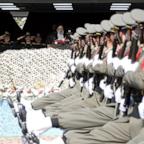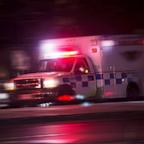Celebrating the People Behind Curiosity's Year on Mars
It takes a village of scientists and engineers to raise a rover.
Aug. 6, 2013— -- intro: Since landing on Mars a year ago, Curiosity has almost taken on a human-like persona. Its Twitter and Facebook accounts update in the first person while promoting the hashtag #1YearOnMars. It takes selfies, complete with the obligatory awkward angle. It's sometimes easy to forget that there are actual people behind the Mars rover.
Rewatching "7 Minutes of Terror," a video that details the intricacies of landing on Mars, reminds us that it took a team of dedicated scientists and engineers to make this happen.
Footage from the Jet Propulsion Laboratory's control room in California was streamed live to millions of viewers on a late Sunday night, or early Monday morning, depending on the time zone.
The people crammed in that very control room are still just a fraction of the team that worked on Curiosity. Whether it was shrinking the instruments of the Sample Analysis at Mars in order to make a portable chemistry lab, or deploying both a parachute and a sky crane to make sure that Curiosity didn't crash onto the red planet's surface, hundreds of scientists and engineers poured their energy into the not-so-little rover that could.
ABC News spoke with a handful of these people to learn about what went on behind the scenes and what we've learned from Curiosity so far. The following interviews are edited and condensed versions of those conversations. Click through to meet some of the people behind Curiosity's success.
Note: You can view this entire article on one page by selecting the "View All" in the upper right corner, next to the Print icon.
quicklist: 1category: Flight Director, Systems Engineertitle: Bobak Ferdowsitext: What is your specific role with Curiosity?
I was responsible for what we call the launch, cruise, and approach integrated testing. We tested all the various activities of the mission, from the rocket's launch to when it started to hit the atmosphere of Mars. The night [of the landing], I was one of the activity leads monitoring the telemetry, basically the state and health of the spacecraft.
How confident were you on landing day?
We tested all that we could test and threw as many wrenches that we could. But the amazing thing about Mars or any planet are all the unknown unknowns, the things that we can't foresee. I think all of us were very nervous, but almost everything [involved in the landing] went like a choreographed dance.
What's most interesting about this mission to you?
What's amazing to me that maybe people don't realize is that we are posting the pictures and data to the web within 24 hours when we get it. That still just blows my mind, that people can see it and experience it for themselves almost at the same time that we do.
media: 19876410
quicklist: 2category: Principal Investigator: Sample Analysis on Mars (SAM)title: Paul Mahaffytext: What have we learned so far from Curiosity?
Some of the layers near the base of Mount Sharpe show evidence of hydrated minerals, suggesting that there was some aqueous process in the Gale Crater. Maybe there was a lake, but how big was it and how much water was in it? It's not clear yet, but looking at the minerology, you start to unravel the history of Mars.
Check out how SAM celebrated Curiosity's first year on Mars
Have there been any surprises along the way?
You really learn a lot about how long it actually takes to do certain things. At a dust pile near Rocknest, we anticipated that we might be there for only two or three weeks, but ended up pushing two months. It often turns out that things go a lot slower than you planned.
Are you involved with other projects than Curiosity?
Some other projects have been keeping me busy. In a few weeks, we're launching LADEE to orbit the moon and and look at its thin atmosphere. There is also MAVEN, which will orbit Mars, look at its atmosphere, and extrapolate back to what it was like billions of years ago.
media: 19876436
quicklist: 3
category: Principal Investigator: Supersonic Parachute
title: Anita Sengupta
text: How did you get involved with Curiosity?
The mechanical systems division said, "We need someone to start parachute development." They asked me if I wanted to do it, which is a big departure from my field in plasma propulsion systems. But I'm an experimentalist, so it seemed like a good opportunity. It was serendipity, really.
Were there any surprises along the way?
The parachute was turning inside out during the wind tunnel tests. We needed to use high speed imagery to figure out why it was going on. Since the wind tunnel blows horizontally, gravity was pulling the parachute downwards and causing the inversion. It was a huge issue during the development, but that's what happens when you try and simulate falling at twice the speed of sound.
How confident were you on landing day?
I was worried it would be a bad day on Mars. You can have a bad day and deploy at the worst possible conditions. But you design balancing what you expect with the worst possible conditions. It's both a miracle and a neat engineering feat.
media:19876390
quicklist: 4category: Deputy Project Scientisttitle: Ashwin Vasavadatext: What is your specific role with Curiosity?
I help lead the whole international science team. We have 10 different experiments running and over 400 scientists, so we have to figure out how to use every minute of the rover and every ounce of energy we have to do the best possible science.
Were there any surprises along the way?
Around the 200th day on Mars, the computer experienced a malfunction and it just hung there, similar to what your laptop does when it gets confused. It threatened to run down the battery, so we had to quickly diagnose the problem and send some critical commands to tell the computer to go to sleep and recharge its batteries. It was a little scary but we recovered from it.
Are there any experiments that the public don't have much knowledge of?
I think one really important experiment was a radiation detector that we turned on just after launch. We measured the radiation within Curiosity's spacecraft on the journey from Earth to Mars and found that they're just a little bit higher than what's a safe dose for astronauts. That means that NASA needs to design a spacecraft with more shielding than what Curiosity had.
media: 19876400
quicklist: 5category: Mission Managertitle: Rick Welchtext: What is your specific role with Curiosity?
I get to check in with the science and engineering teams every day. Any challenges that we have with the vehicle, I ask "Are we ready to do this?" The worst thing is that you make a quick decision. It's those little things that come to bite you in the end.
How does working on Curiosity compare to previous Mars rovers?
I think there was a high coming off of Spirit and Opportunity and we were willing to jump at any challenge. Curiosity is quite an upgrade, but we wanted to do the next big thing and sign off on a rover with a huge science payload. We ended up delaying the launch for two years, but that's not uncommon in NASA missions.
Any surprises along the way?
There were lots of technical changes in the beginning. The initial parachute test had problems and some of the motors were wearing out their gears much sooner than expected. But I think in the end, we've been very lucky. I think all the systems have operated as they intended to.
media: 19876467




